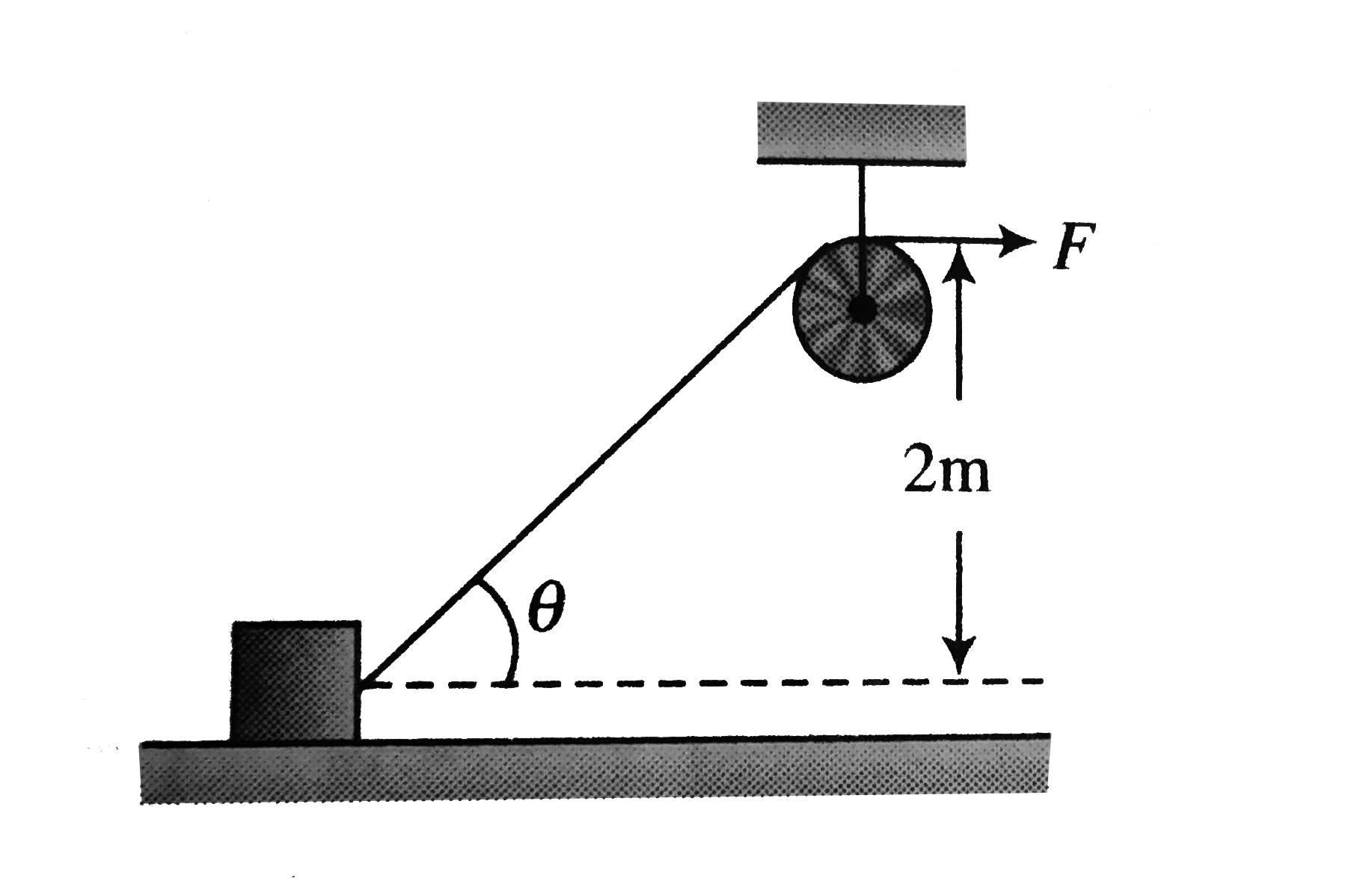A force F=50N is applied at one end of a string, the other end of which is tied to a block of mass 10kg. The block is free to move on a frictionless horizontal surface. Take initial instant as θ=30∘ and final instant as θ=37∘. For the time between these two instants, answer teh following questions?

Net work done by the force F on the block is
(a) 503J
(b) 1003J
(c) 75J
(d) None of these
The correct Answer is:B
l1=2sin30∘=4m, l2=2sin37∘=103m
Displacement of point P:l1−l2=4−103=23m

Work done, W=F(l1−l2)=50×23=1003J
Topper's Solved these Questions
- WORK, POWER & ENERGYBOOK - CENGAGE PHYSICSCHAPTER - WORK, POWER & ENERGYEXERCISE - Integer
14 Videos
- WORK, POWER & ENERGYBOOK - CENGAGE PHYSICSCHAPTER - WORK, POWER & ENERGYEXERCISE - Archives (sinble Correct )
19 Videos
- WORK, POWER & ENERGYBOOK - CENGAGE PHYSICSCHAPTER - WORK, POWER & ENERGYEXERCISE - Multiple Correct
25 Videos
- VECTORSBOOK - CENGAGE PHYSICSCHAPTER - VECTORSEXERCISE - Exercise Multiple Correct
5 Videos
Similar Questions
A block of mass 1kg is tied to a string of length 1m the other end of which is fixed The block is moved on a smooth horizontal table with constant speed 10ms−1. Find the tension in the string
View SolutionTwo block of masses 3kg and 1kg are kept in contact with rach other on a frictionless horizontal surface.If a force of 10N is applied on the larger block what is the acceleration of the system? What is the contact force between the two blocks?
View Solution
Knowledge Check
A force F=50N is applied at one end of a string, the other end of which is tied to a block of mass 10kg. The block is free to move on a frictionless horizontal surface. Take initial instant as θ=30∘ and final instant as θ=37∘. For the time between these two instants, answer teh following questions?

What is the final velocity of the block if initially it was at rest?A(a) √253ms−1B(b) 5ms−1C(c) √203ms−1D(d) None of theseA force F=50N is applied at one end of a string, the other end of which is tied to a block of mass 10kg. The block is free to move on a frictionless horizontal surface. Take initial instant as θ=30∘ and final instant as θ=37∘. For the time between these two instants, answer teh following questions?

Find the ratio of initial acceleration to final acceleration of the blockA3√58B8√35C8√53D5√38Two blocks of masses 2 kg and 4 kg are in close contact on a frictionless horizontal table. A horizontal force of 18 N is applied to the larger mass. What is the force at the surface of contact between the blocks?
A4NB5NC6ND8N
Two blocks of masses 3kg and 1kg are kept in contact with each other on a frictionless horizontal surface.If a force of 10N is applied on the larger block,what is the acceleration of the system? What is the contact force between the two blocks?
View SolutionA block of mass m is pulled along a horizontal surface by applying a force at an angle θ with the horizontal. If the block travels with a uniform velocity and has a displacement d and the coefficient of friction is μ, then the work done by the applied force is
View SolutionThree identical blocks of masses m=2kg are drawn by a force F=10.2N with an acceleration of 0.6ms−2 on a frictionless surface, then what is the tension (in N) in the string between the blocks B and C?

View SolutionA block (A) of mass 3 kg in contact with a second block (B) of mass 2 kg rests on a frictionless horizontal surface. A horizontal force of 20 N is applied to push the block A. What is the force with which the block A pushes the block B?
View SolutionA block of mass 70kg is kept on a rough horizontal surface (μ=0.4) . A person is trying to pull the block by applying a horizontal force, but the block is not moving. The net contact force exerted by the surface on the block is F , then:
View Solution
